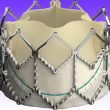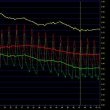Original Title: Transcatheter Replacement of Failed Bioprosthetic Valve. Large Multicenter Assessment of the Effect of Implantation Depth on Hemodynamics after Aortic Valve-in Valve. Reference: Matheus Simonato, et al. Circ. Cardiovasc. Interv 2016;9:e003651 Courtesy of Dr. Carlos Fava. At present, most patients undergoing surgical valve replacement receive a bioprosthetic valve, which lasts from 10 to<a href="https://solaci.org/en/2016/07/12/valve-in-valve-high-or-low-implantation-for-better-outcomes/" title="Read more" >...</a>
Percutaneous mitral valve replacement: First steps
Original Title: Percutaneous Transvenous Transseptal Transcatheter Valve Implantation in Failed Bioprosthetic Mitral Valves, Ring Annuloplasty, and Severe Mitral Annular Calcification. Reference: Eleid MF et al. JACC Cardiovasc Interv. 2016 Jun 13;9(11):1161-74. Courtesy of Dr. Agustín Vecchia. Transfemoral percutaneous transvenous mitral valve implantation is a promising technique and, despite the fact that no devices<a href="https://solaci.org/en/2016/06/16/percutaneous-mitral-valve-replacement-first-steps/" title="Read more" >...</a>
TAVI at 10 Years: First Study to Assess TAVI Long Term Durability
Original Title: First look at long-term durability of transcatheter heart valves: Assessment of valve function up to 10 years after implantation. Presenter: Danny Dvir. Transcatheter aortic valve implantation (TAVI) is being used in increasingly younger patients at low surgical risk, which is why longer survival is expected. The durability of transcatheter aortic prostheses has<a href="https://solaci.org/en/2016/05/19/tavi-at-10-years-first-study-to-assess-tavi-long-term-durability/" title="Read more" >...</a>
New York TAVR Registry: Trends in use and mortality at one year
Original Title: Utilization and 1-Year Mortality for Transcatheter Aortic Valve Replacement and Surgical Aortic Valve Replacement in New York Patients With Aortic Stenosis2011 to 2012. Reference:Hannan EL et al. J Am CollCardiolIntv. 2016;9(6):578-585. Courtesy of Dr. Agustín Vecchia It’s been only 14 years sinceCribierperformed the first transcatheter valve replacement. Today, during 2016, 100,000 patients are expected to<a href="https://solaci.org/en/2016/04/08/new-york-tavr-registry-trends-in-use-and-mortality-at-one-year/" title="Read more" >...</a>
PARTNER 2A: TAVI Not Inferior to Surgery in Intermediate Risk Patients
Transcatheter aortic valve replacement (TAVI) with the new generation balloon expandable valve is at least as good as surgery in intermediate risk patients with severe symptomatic aortic stenosis. For those that can be accessedfemorally, TAVI seems even better than surgery. In all, 2032 intermediate risk patients were randomized in 57 centers to TAVI with Sapien<a href="https://solaci.org/en/2016/04/08/partner-2a-tavi-not-inferior-to-surgery-in-intermediate-risk-patients/" title="Read more" >...</a>
PARTNER 1 in +90 Year Old Patients: TAVI and the Age Paradox
A new analyzis of the PARTNER 1 trial showed that patients over 90 undergoing transcatheter aortic valve replacement (TAVI) show no increase in mortality or major cardiovascular events rates, compared to younger patients. In fact, patients over 90 undergoing TAVI have the same life expectation of someone the same age with no aortic stenosis. In-hospital<a href="https://solaci.org/en/2016/04/08/partner-1-in-90-year-old-patients-tavi-and-the-age-paradox/" title="Read more" >...</a>
The largest series with LOTUS Valve published so far
This work represents the UK experience with the second generation repositionable and retrievable valve Lotus (Boston Scientific, Natick, Massachusetts). It prospectively included 228 patients of mean age 81.4 ± 7.6 and a logistic EuroScore of 17.5 ± 12.4. From the total number of patients, 187 (82%) received the valve for aortic stenosis, 7<a href="https://solaci.org/en/2016/03/08/the-largest-series-with-lotus-valve-published-so-far/" title="Read more" >...</a>
Impact of the Right Atrial Pressure on FFR measurement
Original Title: Impact of the Right Atrial Pressure on Fractional Flow Reserve Measurements Comparison of Fractional flow Reserve and Myocardial Fractional flow Reserve in 1600 Coronary Stenosis. Reference: Toth G, et al. JACC Cardiovasc Interv. 2016 Feb 12. Epub ahead of print. Courtesy of Dr. Guillermo Migliaro. Fractional Flow Reserve (FFR) is the gold standard for the<a href="https://solaci.org/en/2016/02/29/impact-of-the-right-atrial-pressure-on-ffr-measurement/" title="Read more" >...</a>
TAVR é um procedimento tão seguro e eficaz quanto a substituição cirúrgica num seguimento de dois anos em pacientes de menor risco.
Fundamentos e Objetivos: A substituição da válvula aórtica via transcateter (TAVR) é uma opção em determinados pacientes cirúrgicos de alto risco com estenose da válvula aórtica grave. Desconhecemos se a TAVR pode ser introduzida com segurança para os pacientes de baixo risco. O estudo NOTION (Nordic Aortic Valve Intervention Trial) é um ensaio clínico randomizado<a href="https://solaci.org/en/2015/06/24/tavr-e-um-procedimento-tao-seguro-e-eficaz-quanto-a-substituicao-cirurgica-num-seguimento-de-dois-anos-em-pacientes-de-menor-risco-2/" title="Read more" >...</a>
US CoreValve: Cost effectiveness of transcatheter replacement versus surgical replacement in high-risk patients
Previous studies have shown clinical benefits, but also an increased cost to treat patients with symptomatic severe aortic stenosis receiving transcatheter valve replacement (TAVR). There is little consensus regarding the cost-effectiveness for transcatheter versus surgical replacement. The present study was aimed to quantify the quality of life, adjusted survival for quality of life, resource utilization,<a href="https://solaci.org/en/2015/06/24/us-corevalve-cost-effectiveness-of-transcatheter-replacement-versus-surgical-replacement-in-high-risk-patients/" title="Read more" >...</a>








